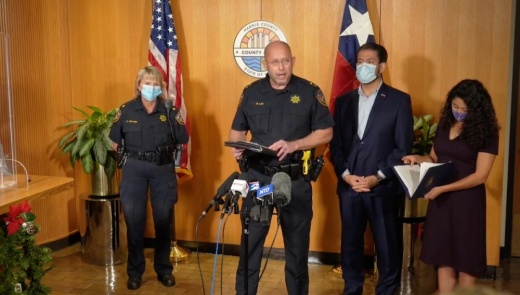A new $2.6 million initiative dubbed the Harris County Safe Program, intended to combat violent crime in unincorporated Harris County, was approved by county commissioners in a unanimous vote Nov. 30.
The three-phase program was developed by the Harris County Sheriff's Office with the support of the county attorney’s office, Judge Lina Hidalgo announced in a Nov. 30 press conference, and is a “data-driven” form of “precision policing.”
“We are strategically pinpointing and then attacking crime, and the best part of it is we are doing it hand in hand with the community,” Hidalgo said.
The first part of the program, which involves data analysis and crime mapping, was already completed by HCSO’s crime analysis and intelligence division. The division used crime analysis to determine seven “microzones” within unincorporated areas of the county that have the highest rates of violent crime.
The seven microzone areas, according to HCSO Assistant Chief Mike Lee, include the intersection of FM 1960 and Kuykendahl Road in Spring; the Aldine area; the intersection of Wood Forest Drive and Uvalde Road, also known as the Northshore area; the Channelview area near I-10; the intersection of West Little York Road and Queenston Boulevard near Eldridge; the area between Franz Road, Park Row, Morton Road and Saums Road in Katy.
It also includes areas along Hwy. 290 and FM 1960; FM 1960 and Jones and Mills roads; West Little York and Gessner roads; Hwy. 6 and West Road; and the Hwy. 6 and Point Northwest Boulevard area in Houston.
Each of the county’s four commissioner precincts include at least one of the targeted zones, Lee said at the press conference, and HCSO’s patrol precincts also cover the zones.
The second stage of the program will be to increase the presence of HCSO constables and deputies in the seven microzones to 96 officers per day. This will increase police visibility in these areas, Hidalgo said, and police will prioritize the arrest of repeat offenders.
The final piece of the program will be to involve community members to deter crime. HCSO will be regularly communicating with the community, Hidalgo said, and collecting data from police body cameras and on disparities.
“They will be ... making sure that there aren’t disproportionate impacts on certain communities, making sure that everything is done fairly,” Hidalgo said.
During the pandemic, crime has risen across the nation and in Harris County, Hidalgo said, with homicide increasing by about 33% and aggravated assault with a deadly weapon rising about 31%. Combatting these crime trends means tackling a wealth of connected contributing factors, Hidalgo said.
“What we can't do is go back to the '80s and '90s and simply say, ‘Build more prisons; lock them all up,’ because no jail is gonna be big enough for that,” Hidalgo said. “And we tried that. And all it did was increase disparities and make us to where we incarcerate more people than any other nation.”





